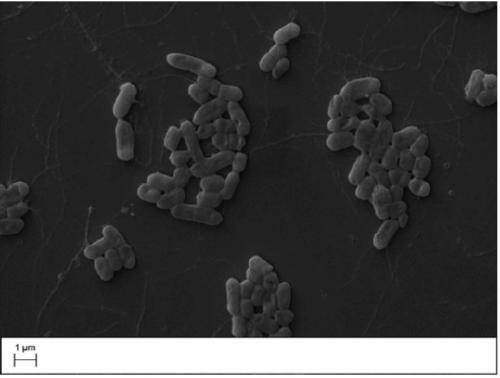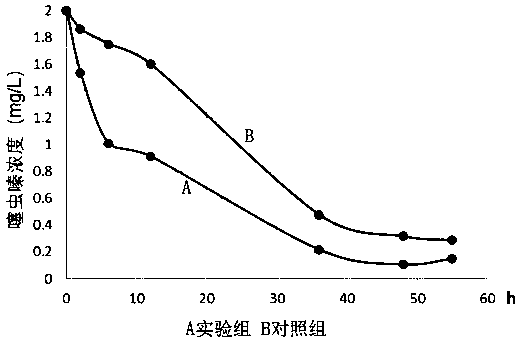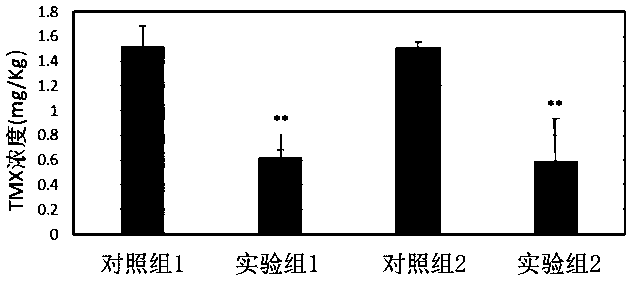Enterobacter mori and application thereof in degrading tahiamethoxam
A technology of Enterobacter mulberry and thiamethoxam, applied in the field of microbiology and food safety
- Summary
- Abstract
- Description
- Claims
- Application Information
AI Technical Summary
Problems solved by technology
Method used
Image
Examples
Embodiment 1
[0028] Example 1 Isolation, identification and degradation function verification of Enterobacter mulberry TMX-13
[0029] 1. Isolation and identification of strain Enterobacter mori sp.TMX-13
[0030] In September 2016, the applicant collected the roots of mulberry plants artificially sprayed with thiamethoxam from the mulberry field in the south of the Jiangsu Academy of Agricultural Sciences, and then sterilized the surface of the mulberry roots, ground them into juice, and applied them on the mulberry plant containing thiamethoxam. On the inorganic salt solid medium as the only carbon and nitrogen source, a plant endophyte strain with thiamethoxam degradation characteristics was screened. The applicant named the bacterium as TMX-13, and its electron microscope pictures are as follows: figure 1 As shown, the strain was rod-shaped, without endophytic spores.
[0031] The TMX-13 strain was identified as Enterobacter mori through physiological and biochemical characteristics ...
Embodiment 2
[0037] The preparation of embodiment 2 TMX-13 microbial agent
[0038] In the present embodiment, TMX-13 bacterial agent is obtained through the following steps:
[0039] A) Inoculate the bacterial strain TMX-13 obtained in Example 1 into LB medium, streak at 30°C, pick a single colony and cultivate it twice, pick a single colony in the strain activation medium, shake at 30°C, 150-220rpm Bed shaking culture for 12-24 hours to obtain activated strains;
[0040] B) Inoculating the activated strain into a fermenter equipped with a seed medium, the inoculum amount is 1% of the volume of the seed medium, at 25-38° C., and culturing in air for 16-24 hours to obtain liquid seeds;
[0041] C) inoculating liquid seeds into a fermenter equipped with seed medium, the inoculum amount is 1% of the volume of the seed medium, and cultivating at 30-35° C. in the dark at 200 rpm until the logarithmic growth phase to obtain a viable cell culture;
[0042] D) Take 50ml of live bacterial cultur...
Embodiment 3
[0043] Example 3 TMX-13 inoculum root irrigation and inoculation to restore thiamethoxam contamination of leafy vegetables
[0044] Sampling the natural soil of farmland, first exposed to the sun and air-dried, and then passing through a 30-mesh sieve to remove oversized stone particles, the soil composition properties are pH 5.97, organic matter content 66.8g / kg dry soil, total nitrogen content 0.36%, total carbon content The hydrogen content is 5.7174%, the total sulfur content is 0.01%, the oxygen content is 44.37%, the clay content is 2.33%, the silt content is 16.1%, and the sand content is 81.5%.
[0045] Soak all the roots of the three-leaf and one-hearted small green vegetable Shanghai Qingming in the TMX-13 bacterial agent obtained in Example 2 for 4 hours, then transplant it to the natural soil of the farmland above, and soak the control group in physiological saline; after 21 days of cultivation, Shanghai Qingming is mature , sprayed thiamethoxam pesticide (purchase...
PUM
 Login to View More
Login to View More Abstract
Description
Claims
Application Information
 Login to View More
Login to View More - R&D Engineer
- R&D Manager
- IP Professional
- Industry Leading Data Capabilities
- Powerful AI technology
- Patent DNA Extraction
Browse by: Latest US Patents, China's latest patents, Technical Efficacy Thesaurus, Application Domain, Technology Topic, Popular Technical Reports.
© 2024 PatSnap. All rights reserved.Legal|Privacy policy|Modern Slavery Act Transparency Statement|Sitemap|About US| Contact US: help@patsnap.com










